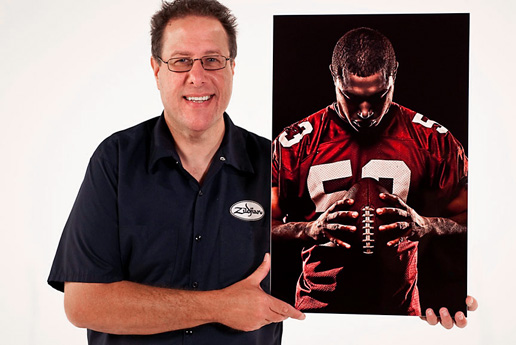My First Prints on Metal
I’m not talking about “metallic prints” (which are prints made on Kodak metallic-finish paper) I’m talking about images actually printed on metal (well, Aluminum to be exact). I got two different kinds in the past two weeks, from two different sources, so I’m going to cover them both here.
First, the print I’m holding above, which is from Image Wizards, and it’s one of their “AluminArte” images (which they call, “High Definition Images on Aluminum”).
On their site (link) they make a pretty bold statement:
“Remember the first time you saw HDTV? Our AluminArte samples will show you a level of imaging never seen before.”
I have to admit—it’s actually right on the money. My buddy Matt Kloskowski had the first AluminArte print I’d ever seen (it was of his amazing landscape shot of a barn in Washington State’s Polouse region), and when it came in the office, we all just stood around it slack-jawed. I’d never seen anything like it. Then when mine print came in (shown above), we all did the same thing—the depth and detail is like what you see on HDTV (compared to regular broadcast).
The sad thing is—-in a regular photo of it (like you see above—photo by Brad Moore), you lose all that depth and dimension that you see so clearly in person (just imagine seeing a HDTV image on a regular TV with no HD and you know what I mean). I found a video on their site, about the process, but again, because it’s video, it can’t show the depth of this type of printing on any level (this is just one of those “you have to see it with your own eyes” type of things).
Anyway, I’m incredibly impressed, and I’m going to have some of my favorite images reprinted as AluminArte images when I get back from Photoshop World. Here’s the link to their site.
Now, onto the 2nd type of metallic printed image:
This one is actually a six-piece mural (made up of six 12″x12″ metallic tiles) from Metal Murals and although theirs isn’t the Hi-Def type of images that I got from Image Wizards, the impact here comes from the size and presentation.
The funny thing is; these two types of images had a different impact on different groups of people. The photographers in my office lost their minds over the quality of the Hi-Def image (shown above), but everybody (the non-serious photo crowd) were all taken in by the mural. Everybody was talking about it when it came in (and a bunch of golfers in the office wanted to snag it for their office).
The pole they’re connected to (shown here, with the help of Brad Moore—photo by Matt Kloskowski), are also how you mount them to your wall (it came with the mounts, and it’s pretty darn clever how the whole thing works).
Also, you can buy a much smaller 12″x12″ sample version (the size of just one tile) if you want to make a proof for your client before creating the final full-sized mural. Since the mural will have gaps, I think this is really a smart idea—especially if you’re creating a really large mural (these murals can be any size, and not just made up of 12″x12″ squares, and you can have more than just six squares).
They’ve got a page of samples on their site (link) and from their sample page, these must be very popular for tradeshow displays (or it just includes a lot of photos from their own tradeshow booth—I couldn’t tell). Here’s the link to Metal Murals Website.
Anyway, despite the fact that the ‘metallic-ness’ of both types of printing get totally lost when you show a regular photo of them (like you see here), when you see them in person—-either one—-you’ll be amazed at how much impact they have.
